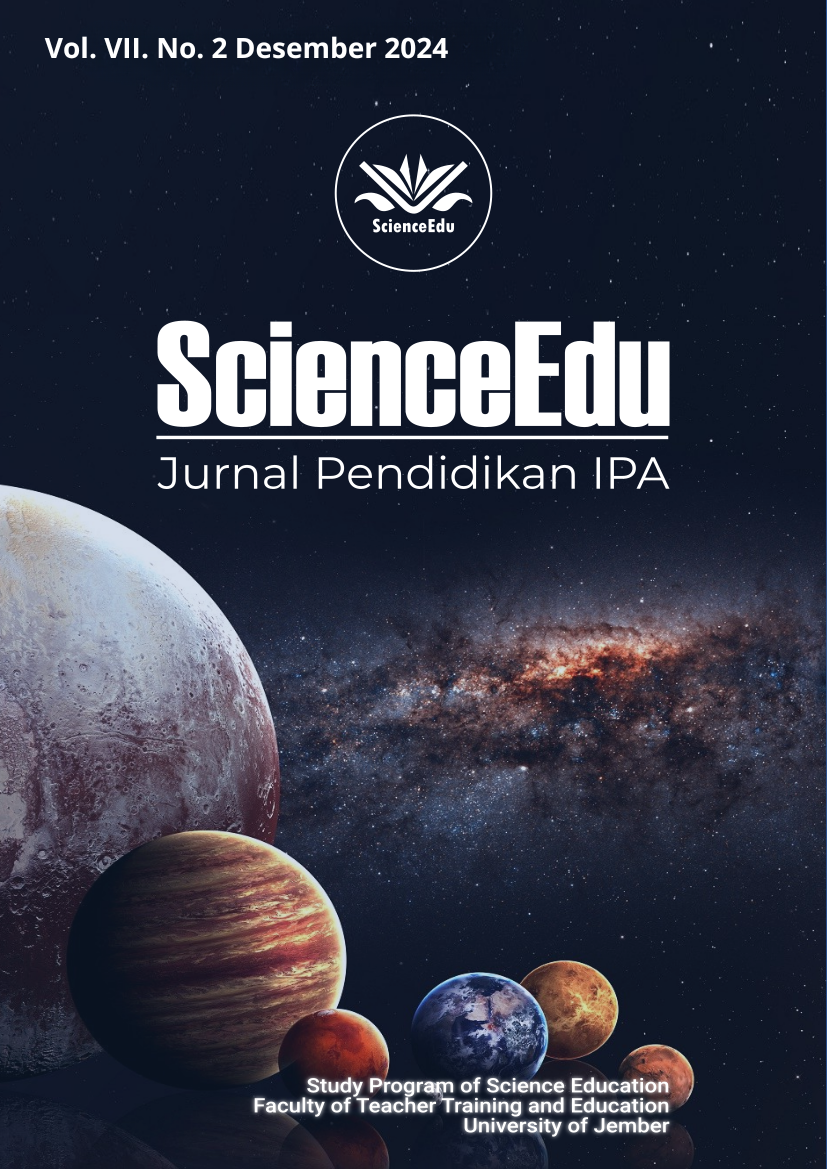Penggunaan Animasi stop-motion oleh Siswa SMP dalam Mengembangkan Pemahaman Konsep Energi
Keywords:
Stop-motion animation, concepts understanding, , energy, modellingAbstract
In physics education, many abstract concepts such as energy cannot be directly observed, necessitating instructional methods that effectively convey these abstract ideas. This study explores how students creating stop-motion animations can aid in developing their understanding of energy concepts. Employing a qualitative case-study approach, the research methodology involves five stages: preparation, introduction, phenomenon introduction, animation creation, and discussion. Findings indicate that students' engagement in stop-motion animation facilitates the development of their understanding of energy concepts. The research highlights that students' creation of phase designs helps them visualize moment-by-moment energy aspects in the motion of a tennis ball, fostering diverse understandings among students. Moreover, the study underscores the role of chunking and sequencing processes in enhancing students' conceptual understanding.
Downloads
References
Atkins, L. J., Erstad, C., Gudeman, P., McGowan, J., Mulhern, K., Prader, K., Rodriguez, G., Showaker, A., & Timmons, A. 2014. Animating Energy: stop-motion Animation and Energy Tracking Representations. The Physics Teacher. 52(3): 152–156. https://doi.org/10.1119/1.4865517.
Bachtiar, R. W., Meulenbroeks, R. F. G., & van Joolingen, W. R. 2021. Stimulating Mechanistic Reasoning in Physics Using Student-Constructed stop-motion Animations. Journal of Science Education and Technology. 30(6): 777–790. https://doi.org/10.1007/s10956-021-09918-z.
Bachtiar, R. W., Meulenbroeks, R. F. G., & van Joolingen, W. R. 2024. Understanding how student-constructed stop-motion animations promote mechanistic reasoning: A theoretical framework and empirical evidence. Journal of Research in Science Teaching. 61(2): 289–318. https://doi.org/https://doi.org/10.1002/tea.21891.
Bächtold, M. 2018. How Should Energy Be Defined Throughout Schooling? Research in Science Education. 48(2): 345–367. https://doi.org/10.1007/s11165-016-9571-5.
Bakri, F., Wahyuni, Permana, A. H., & Sumardani, D. 2021. Textbook Enriched with Video Augmented Reality: Contextual in Motion Concept Learning in Junior High School. AIP Conference Proceedings. 2320(March). https://doi.org/10.1063/5.0037614.
Berg, A., Orraryd, D., Pettersson, A. J., & Hultén, M. 2019. Representational challenges in animated chemistry: self-generated animations as a means to encourage students’ reflections on sub-micro processes in laboratory exercises. Chemistry Education Research and Practice. 20(4): 710–737. https://doi.org/10.1039/C8RP00288F.
Chen, R. F., Eisenkraft, A., Fortus, D., Krajcik, J., Neumann, K., Nordine, J., & Scheff, A. 2014. Teaching and learning of energy in K-12 education. Teaching and Learning of Energy in K-12 Education. 1(1): 1–379. https://doi.org/10.1007/978-3-319-05017-1.
Hoban, G., & Nielsen, W. 2010. The 5 Rs: A new teaching approach to encourage slowmations (student-generated animations) of science concepts. Teaching Science. 3(3): 33–38.
Kubsch, M., Nordine, J., Fortus, D., Krajcik, J., & Neumann, K. 2020. Supporting Students in Using Energy Ideas to Interpret Phenomena: The Role of an Energy Representation. International Journal of Science and Mathematics Education. 18(8): 1635–1654. https://doi.org/10.1007/s10763-019-10035-y.
Kubsch, M., Opitz, S., Nordine, J., Neumann, K., Fortus, D., & Krajcik, J. 2021. Exploring a pathway towards energy conservation through emphasizing the connections between energy, systems, and fields. Disciplinary and Interdisciplinary Science Education Research. 3(1): 2. https://doi.org/10.1186/s43031-020-00030-7.
Opitz, S. 2015. Students’ Energy Concepts at the Transition Between Primary and Secondary School. Research in Science Education. 45: 691–715. https://doi.org/10.1007/s11165-014-9444-8.
Papadouris, N., & Constantinou, C. P. 2011. A Philosophically Informed Teaching Proposal on the Topic of Energy for Students Aged 11–14. Science & Education. 20(10): 961–979. https://doi.org/10.1007/s11191-010-9305-4.
Park, M., & Liu, X. 2021. An Investigation of Item Difficulties in Energy Aspects Across Biology, Chemistry, Environmental Science, and Physics. Research in Science Education. 51(1): 43–60. https://doi.org/10.1007/s11165-019-9819-y.
Toli, G., & Kallery, M. 2021. Enhancing Student Interest to Promote Learning in Science: The Case of the Concept of Energy. In Education Sciences. 11(5)111-119. https://doi.org/10.3390/educsci11050220


